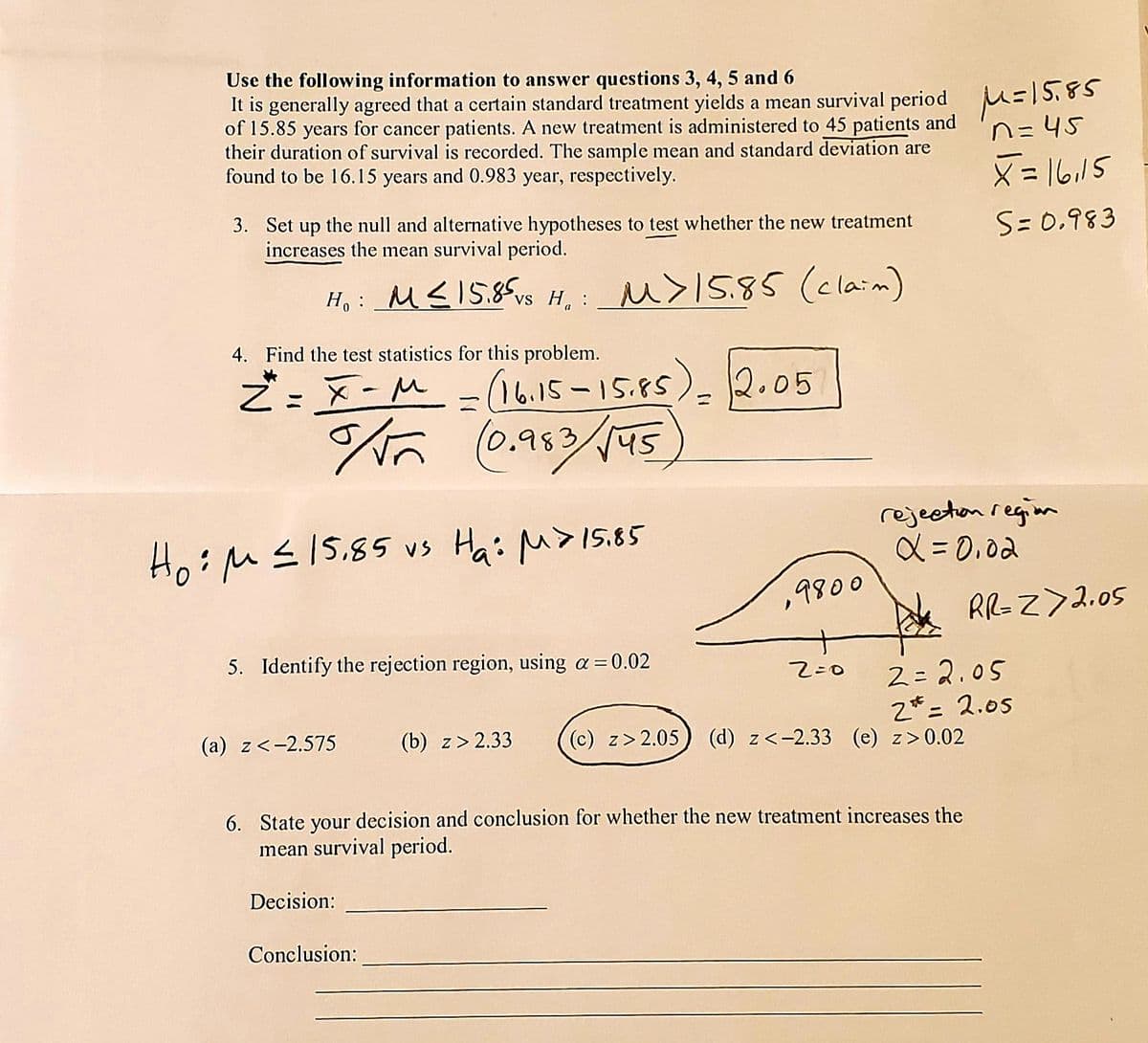Use the following information to answer questions 3, 4, 5 and 6 It is generally agreed that a certain standard treatment yields a mean survival period M=1S.85 of 15.85 years for cancer patients. A new treatment is administered to 45 patients and their duration of survival is recorded. The sample mean and standard deviation are found to be 16.15 years and 0.983 year, respectively. n=45 X = 16,15 3. Set up the null and alternative hypotheses to test whether the new treatment increases the mean survival period. S= 0.983 H, : M15.85 (claim) 4. Find the test statistics for this problem. (16.15-15.85 (0.983M5 ビ:x- M 2.05 ニ Ho:M 2.05 5. Identify the rejection region, using a =0.02 Z=0 2= 2.05 2*= 2.05 (d) z<-2.33 (e) z>0.02 (a) z<-2.575 (b) z> 2.33 (c) z> 2.05 6. State your decision and conclusion for whether the new treatment increases the mean survival period. Decision: Conclusion:
Use the following information to answer questions 3, 4, 5 and 6 It is generally agreed that a certain standard treatment yields a mean survival period M=1S.85 of 15.85 years for cancer patients. A new treatment is administered to 45 patients and their duration of survival is recorded. The sample mean and standard deviation are found to be 16.15 years and 0.983 year, respectively. n=45 X = 16,15 3. Set up the null and alternative hypotheses to test whether the new treatment increases the mean survival period. S= 0.983 H, : M15.85 (claim) 4. Find the test statistics for this problem. (16.15-15.85 (0.983M5 ビ:x- M 2.05 ニ Ho:M 2.05 5. Identify the rejection region, using a =0.02 Z=0 2= 2.05 2*= 2.05 (d) z<-2.33 (e) z>0.02 (a) z<-2.575 (b) z> 2.33 (c) z> 2.05 6. State your decision and conclusion for whether the new treatment increases the mean survival period. Decision: Conclusion:
Glencoe Algebra 1, Student Edition, 9780079039897, 0079039898, 2018
18th Edition
ISBN:9780079039897
Author:Carter
Publisher:Carter
Chapter10: Statistics
Section10.3: Measures Of Spread
Problem 26PFA
Related questions
Question
100%
If the test statistic equals the rejection region, do we make a decision that we reject the Ho? So if we reject Ho, what is our conclusion?? there is sufficient evidence that we believe the Ha... the mean survival period is greater than 15.85 years? Thank you.

Transcribed Image Text:Use the following information to answer questions 3, 4, 5 and 6
It is generally agreed that a certain standard treatment yields a mean survival period =|5,85
of 15.85 years for cancer patients. A new treatment is administered to 45 patients and
their duration of survival is recorded. The sample mean and standard deviation are
found to be 16.15 years and 0.983 year, respectively.
n=45
X= 16,15
3. Set up the null and alternative hypotheses to test whether the new treatment
increases the mean survival period.
S= 0.983
H, : _M<15.85vs H, : _u>15.85 (claim)
4. Find the test statistics for this problem.
ご:x-M - ). 12.05
16.15-15.85
(0.953
45
Ho:M</5.85 vs Hai M>I5.85
rejecton regim
メ= 0.0d
9800
RR-Z> 2.05
5. Identify the rejection region, using a=0.02
2= 2.05
2*= 2.05
(c) z>2.05) (d) z<-2.33 (e) z>0.02
%3D
(a) z<-2.575
(b) z> 2.33
6. State your decision and conclusion for whether the nev
mean survival period.
treatment increases the
Decision:
Conclusion:
Expert Solution
This question has been solved!
Explore an expertly crafted, step-by-step solution for a thorough understanding of key concepts.
Step by step
Solved in 2 steps with 1 images

Knowledge Booster
Learn more about
Need a deep-dive on the concept behind this application? Look no further. Learn more about this topic, statistics and related others by exploring similar questions and additional content below.Recommended textbooks for you

Glencoe Algebra 1, Student Edition, 9780079039897…
Algebra
ISBN:
9780079039897
Author:
Carter
Publisher:
McGraw Hill

Glencoe Algebra 1, Student Edition, 9780079039897…
Algebra
ISBN:
9780079039897
Author:
Carter
Publisher:
McGraw Hill